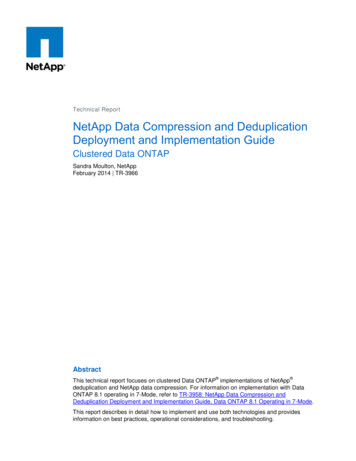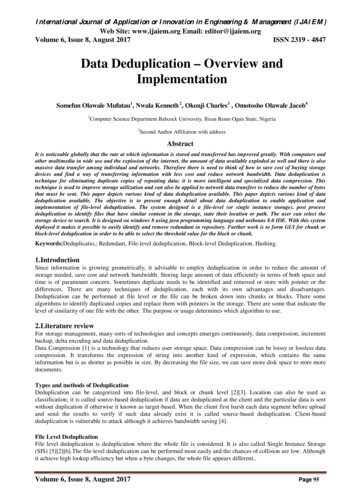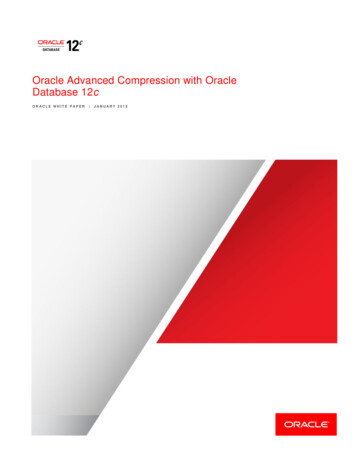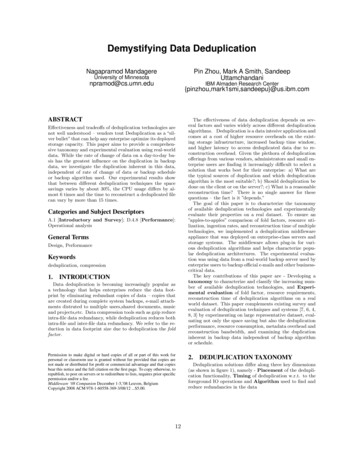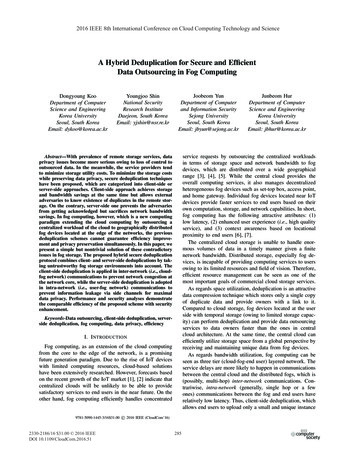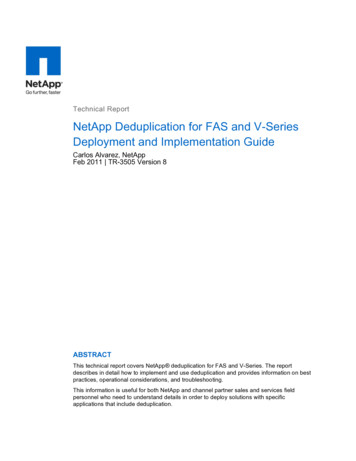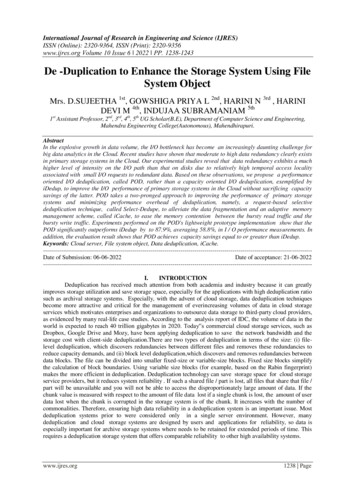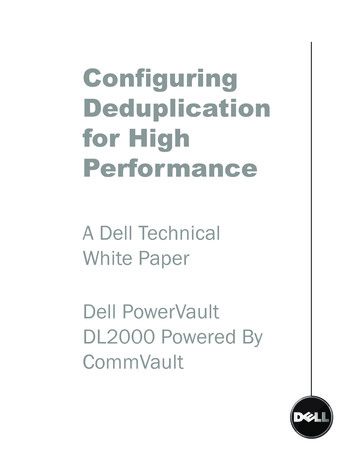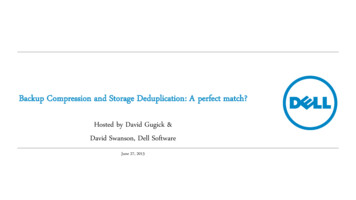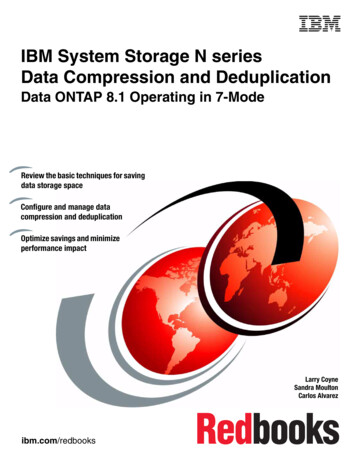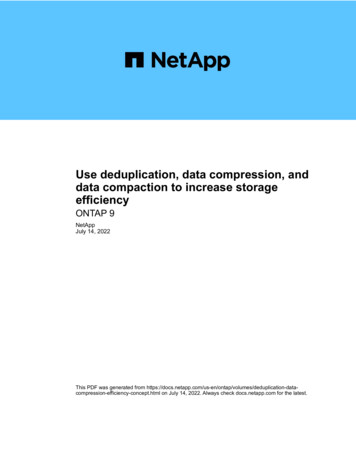
Transcription
Use deduplication, data compression, anddata compaction to increase storageefficiencyONTAP 9NetAppJuly 14, 2022This PDF was generated from ication-datacompression-efficiency-concept.html on July 14, 2022. Always check docs.netapp.com for the latest.
Table of ContentsUse deduplication, data compression, and data compaction to increase storage efficiency . . . . . . . . . . . . . . . . 1Use deduplication, data compression, and data compaction to increase storage efficiency overview . . . . . . 1Enable deduplication on a volume . . . . . . . . . . . . . . . . . . . . . . . . . . . . . . . . . . . . . . . . . . . . . . . . . . . . . . . . . . 1Disable deduplication on a volume . . . . . . . . . . . . . . . . . . . . . . . . . . . . . . . . . . . . . . . . . . . . . . . . . . . . . . . . . 2Manage automatic volume-level background deduplication on AFF systems . . . . . . . . . . . . . . . . . . . . . . . . . 3Manage aggregate-level inline deduplication on AFF systems . . . . . . . . . . . . . . . . . . . . . . . . . . . . . . . . . . . . 3Manage aggregate-level background deduplication on AFF systems . . . . . . . . . . . . . . . . . . . . . . . . . . . . . . . 4Temperature-sensitive storage efficiency overview . . . . . . . . . . . . . . . . . . . . . . . . . . . . . . . . . . . . . . . . . . . . . 5Set storage efficiency mode during volume creation . . . . . . . . . . . . . . . . . . . . . . . . . . . . . . . . . . . . . . . . . . . . 5Check volume efficiency mode . . . . . . . . . . . . . . . . . . . . . . . . . . . . . . . . . . . . . . . . . . . . . . . . . . . . . . . . . . . . 6Change volume efficiency mode . . . . . . . . . . . . . . . . . . . . . . . . . . . . . . . . . . . . . . . . . . . . . . . . . . . . . . . . . . . 7Enable data compression on a volume . . . . . . . . . . . . . . . . . . . . . . . . . . . . . . . . . . . . . . . . . . . . . . . . . . . . . . 7Move between secondary compression and adaptive compression . . . . . . . . . . . . . . . . . . . . . . . . . . . . . . . . 9Disable data compression on a volume . . . . . . . . . . . . . . . . . . . . . . . . . . . . . . . . . . . . . . . . . . . . . . . . . . . . . 10Manage inline data compaction for AFF systems. . . . . . . . . . . . . . . . . . . . . . . . . . . . . . . . . . . . . . . . . . . . . . 11Enable inline data compaction for FAS systems . . . . . . . . . . . . . . . . . . . . . . . . . . . . . . . . . . . . . . . . . . . . . . 11Inline storage efficiency enabled by default on AFF systems . . . . . . . . . . . . . . . . . . . . . . . . . . . . . . . . . . . . 12Enable storage efficiency visualization . . . . . . . . . . . . . . . . . . . . . . . . . . . . . . . . . . . . . . . . . . . . . . . . . . . . . 13Create a volume efficiency policy to run efficiency operations. . . . . . . . . . . . . . . . . . . . . . . . . . . . . . . . . . . . 14Manage volume efficiency operations manually . . . . . . . . . . . . . . . . . . . . . . . . . . . . . . . . . . . . . . . . . . . . . . 16Manage volume efficiency operations using schedules . . . . . . . . . . . . . . . . . . . . . . . . . . . . . . . . . . . . . . . . . 19Monitor volume efficiency operations . . . . . . . . . . . . . . . . . . . . . . . . . . . . . . . . . . . . . . . . . . . . . . . . . . . . . . . 20Stop volume efficiency operations . . . . . . . . . . . . . . . . . . . . . . . . . . . . . . . . . . . . . . . . . . . . . . . . . . . . . . . . . 22Information about removing space savings from a volume . . . . . . . . . . . . . . . . . . . . . . . . . . . . . . . . . . . . . . 22
Use deduplication, data compression, and datacompaction to increase storage efficiencyUse deduplication, data compression, and data compactionto increase storage efficiency overviewYou can run deduplication, data compression, and data compaction together orindependently to achieve optimal space savings on a FlexVol volume. Deduplicationeliminates duplicate data blocks. Data compression compresses the data blocks toreduce the amount of physical storage that is required. Data compaction stores moredata in less space to increase storage efficiency.Beginning with ONTAP 9.2, all inline storage efficiency features, such as inline deduplicationand inline compression, are enabled by default on AFF volumes.Enable deduplication on a volumeYou can enable deduplication on a FlexVol volume to achieve storage efficiency. You canenable postprocess deduplication on all volumes and inline deduplication on volumes thatreside on AFF or Flash Pool aggregates.If you want to enable inline deduplication on other types of volumes, see the Knowledge Base article How toenable volume inline deduplication on Non-AFF (All Flash FAS) aggregates.What you’ll needFor a FlexVol volume, you must have verified that enough free space exists for deduplication metadata involumes and aggregates. The deduplication metadata requires a minimum amount of free space in theaggregate. This amount is equal to 3% of the total amount of physical data for all deduplicated FlexVolvolumes or data constituents within the aggregate. Each FlexVol volume or data constituent should have 4% ofthe total amount of physical data’s worth of free space, for a total of 7%.Beginning with ONTAP 9.2, inline deduplication is enabled by default on AFF systems.Choices Use the volume efficiency on command to enable postprocess deduplication.The following command enables postprocess deduplication on volume VolA:volume efficiency on -vserver vs1 -volume VolA Use the volume efficiency on command followed by the volume efficiency modify commandwith the -inline-deduplication option set to true to enable both postprocess deduplication andinline deduplication.The following commands enable both postprocess deduplication and inline deduplication on volume VolA:volume efficiency on -vserver vs1 -volume VolA1
volume efficiency modify -vserver vs1 -volume VolA -inline-dedupe true Use the volume efficiency on command followed by the volume efficiency modify commandwith the -inline-deduplication option set to true and the -policy option set to inline-only toenable only inline deduplication.The following commands enable only inline deduplication on volume VolA:volume efficiency on -vserver vs1 -volume VolAvolume efficiency modify -vserver vs1 -volume VolA -policy inline-only -inline-dedupe trueAfter you finishVerify that the setting has changed by viewing the volume efficiency settings: volume efficiency show-instanceDisable deduplication on a volumeYou can disable postprocess deduplication and inline deduplication independently on avolume.What you’ll needStop any volume efficiency operation that is currently active on the volume: volume efficiency stopAbout this taskIf you have enabled data compression on the volume, running the volume efficiency off commanddisables data compression.Choices Use the volume efficiency off command to disable both postprocess deduplication and inlinededuplication.The following command disable both postprocess deduplication and inline deduplication on volume VolA:volume efficiency off -vserver vs1 -volume VolA Use the volume efficiency modify command with the -policy option set to inline only todisable postprocess deduplication, but inline deduplication remains enabled.The following command disables postprocess deduplication, but inline deduplication remains enabled onvolume VolA:volume efficiency modify -vserver vs1 -volume VolA -policy inline-only Use the volume efficiency modify command with the -inline-deduplication option set tofalse to disable inline deduplication only.The following command disables only inline deduplication on volume VolA:volume efficiency modify -vserver vs1 -volume VolA -inline-deduplication false2
Manage automatic volume-level background deduplicationon AFF systemsBeginning with ONTAP 9.3, volume-level background deduplication can be managed torun automatically using a predefined auto AFF policy. No manual configuration of theschedules is required. The auto policy performs continuous deduplication in thebackground.The auto policy is set for all newly created volumes and for all upgraded volumes that have not been manuallyconfigured for background deduplication. You can change the policy to default or any other policy to disablethe feature.If a volume moves from a non-AFF system to an AFF system, the auto policy is enabled on the destinationnode by default. If a volume moves from an AFF node to a non-AFF node, the auto policy on the destinationnode is replaced by the inline-only policy by default.On AFF, the system monitors all the volumes having the auto policy and deprioritizes the volume that has lesssavings or has frequent overwrites. The deprioritized volumes no longer participate in automatic backgrounddeduplication. Change logging on deprioritized volumes is disabled and metadata on the volume is truncated.Users can promote the deprioritized volume to re-participate in an automatic background deduplication usingthe volume efficiency promote command available at the advanced privilege level.Manage aggregate-level inline deduplication on AFFsystemsAggregate-level deduplication eliminates duplicate blocks across volumes belonging tothe same aggregate. Beginning with ONTAP 9.2, you can perform aggregate-leveldeduplication inline on AFF systems. The feature is enabled by default for all newlycreated volumes and all upgraded volumes with volume inline deduplication turned on.About this taskThe deduplication operation eliminates duplicate blocks before data is written to disk. Only volumes with thespace guarantee set to none can participate in aggregate-level inline deduplication. This is the defaultsetting on AFF systems.Aggregate-level inline deduplication is sometimes referred to as cross-volume inlinededuplication.Step1. Manage aggregate-level inline deduplication on AFF systems:If you want to Use this commandEnable aggregate-level inline deduplicationvolume efficiency modify -vservervserver name -volume vol name -cross-volume-inline-dedupe true3
If you want to Use this commandDisable aggregate-level inline deduplicationvolume efficiency modify -vservervserver name -volume vol name -cross-volume-inline-dedupe falseDisplay aggregate-level inline deduplication statusvolume efficiency config -volumevol nameExamplesThe following command displays the aggregate-level inline deduplication status:wfit-8020-03-04:: volume efficiency config -volume choke0 wfit 8020 03 0Vserver:vs0Volume:choke0 wfit 8020 03 0Schedule:Policy:choke VE policyCompression:trueInline Compression:trueInline Dedupe:trueData Compaction:trueCross Volume Inline Deduplication:falseManage aggregate-level background deduplication on AFFsystemsAggregate-level deduplication eliminates duplicate blocks across volumes belonging tothe same aggregate. Beginning with ONTAP 9.3, you can perform aggregate-leveldeduplication in the background on AFF systems. The feature is enabled by default for allnewly created volumes and all upgraded volumes with volume background deduplicationturned on.About this taskThe operation is triggered automatically when a large enough percentage of the change log has beenpopulated. No schedule or policy is associated with the operation.Beginning with ONTAP 9.4, AFF users can also run the aggregate-level deduplication scanner to eliminateduplicates of existing data across volumes in the aggregate. You can use the storage aggregateefficiency cross-volume-dedupe start command with the -scan-old-data true option to startthe scanner:cluster-1:: storage aggregate efficiency cross-volume-dedupe start-aggregate aggr1 -scan-old-data true4
Deduplication scanning can be time-consuming. You might want to run the operation in off-peak hours.Aggregate-level background deduplication is sometimes referred to as cross-volumebackground deduplication.Step1. Manage aggregate-level background deduplication on AFF systems:If you want to Use this commandEnable aggregate-level background deduplicationvolume efficiency modify -vserver vserver name\ -volume vol name\ -cross-volume-background-dedupe trueDisable aggregate-level background deduplicationvolume efficiency modify -vserver vserver name\ -volume vol name\ -cross-volume-background-dedupe falseDisplay aggregate-level background deduplicationstatusaggregate efficiency cross-volumededupe showTemperature-sensitive storage efficiency overviewTemperature-sensitive storage efficiency was introduced in ONTAP 9.8 and was enabledautomatically on newly created thin-provisioned AFF volumes. Starting with ONTAP9.10.1, you enable temperature-sensitive storage efficiency on newly created AFFvolumes and on existing AFF volumes. Additionally, two modes are introduced: default,which is the performance-based mode, which is enabled by default, and efficient mode,which you must enable.Accomplishing storage efficiency depends on a correct assessment of your data’s “temperature;” meaning,how frequently the data is accessed. Temperature-sensitive storage efficiency is determined by thetemperature of a volume’s data. For cold data, larger data blocks are compressed, and for hot data, which isoverwritten more often, smaller data blocks are compressed, making the process more efficient.Both storage efficiency modes are supported on FabricPool-enabled aggregates and with all tiering policytypes.Upgrade considerationsWhen upgrading to Data ONTAP 9.10.1, existing volumes are assigned a storage efficiency mode based onthe type of compression currently enabled on the volumes. During an upgrade, volumes with compressionenabled are assigned the default mode, and volumes with temperature-sensitive storage efficiency enabled areassigned the efficient mode. If compression is not enabled, storage efficiency mode remains blank.Set storage efficiency mode during volume creationBeginning with ONTAP 9.10.1, you can set the storage efficiency mode when creating a5
new AFF volume. Using the parameter -storage-efficiency-mode, you can specifywhether the volume uses either the efficient mode or the default performance mode. The-storage-efficiency-mode parameter is not supported on non-AFF volumes or ondata protection volumes.Create a new volume using efficient modeTo set the efficiency mode when enabling storage efficiency, you can use the -storage-efficiency-modeparameter with the value efficient.Step1. Create a new volume with efficiency mode enabled:volume create -vserver vserver name -volume volume name -aggregate aggregate name -size volume size -storage-efficiency-mode efficientvolume create -vserver vs1 -volume aff vol1 -aggregate aff aggr1-storage-efficiency-mode efficient -size 10gCreate a new volume using performance modesPerformance mode is set by default when you create new AFF volumes with temperature-sensitive storageefficiency. Optionally, you can use the default value with the -storage-efficiency-mode parameter.Step1. Create a new volume with efficiency mode enabled:volume create -vserver vserver name -volume volume name -aggregate aggregate name -size volume size -storage-efficiency-mode defaultvolume create -vserver vs1 -volume aff vol1 -aggregate aff aggr1 -storage-efficiency-mode default -size 10gSystem Manager procedureBeginning with ONTAP 9.10.1, you can use System Manager to enable higher storage efficiency using thetemperature-sensitive storage efficiency feature. Performance-based storage efficiency is enabled by default.1. Click Storage Volumes.2. Locate the volume on which you want to enable or disable storage efficiency, and click .3. Click Edit, and scroll to Storage Efficiency.4. Select Enable Higher Storage Efficiency.Check volume efficiency modeYou can use the volume-efficiency-show command on an AFF volume to check6
whether efficiency is set and to view the current efficiency mode.Step1. Check the efficiency mode on a volume:volume efficiency show -vserver vserver name -volume volume name -fieldsstorage-efficiency-modeChange volume efficiency modeYou can use the volume efficiency modify command to change the storageefficiency mode that’s set on an AFF volume. You can change the mode from default toefficient or you can set an efficiency mode when volume efficiency is not already set.Steps1. Change the volume efficiency mode:volume efficiency modify -vserver vserver name -volume volume name -storage-efficiency-mode default efficient Enable data compression on a volumeYou can enable data compression on a FlexVol volume to achieve space savings byusing the volume efficiency modify command. You can enable data compressionon a FlexVol volume to achieve space savings by using the volume efficiencymodify command. You can also assign a compression type to your volume, if you do notwant the default compression type.What you’ll needYou must have enabled deduplication on the volume. Deduplication only needs to be enabled and does not need to be running on the volume. The compression scanner must be used to compress the existing data on the volumespresent in AFF platforms.Enabling deduplication on a volumeAbout this task In HDD aggregates and Flash Pool aggregates, you can enable both inline and postprocess compressionor only postprocess compression on a volume.If you are enabling both, then you must enable postprocess compression on the volume before enablinginline compression. In AFF platforms, only inline compression is supported.Before enabling inline compression, you must enable postprocess compression on the volume. However,because postprocess compression is not supported in AFF platforms, no postprocess compression takes7
place on those volumes and an EMS message is generated informing you that postprocess compressionwas skipped. Temperature sensitive storage efficiency is introduced in ONTAP 9.8. With this feature, storage efficiency isapplied according to whether data is hot or cold. For cold data, larger data blocks are compressed, and forhot data, which is overwritten more often, smaller data blocks are compressed, making the process moreefficient. Temperature sensitive storage efficiency is enabled automatically on newly created thinprovisioned AFF volumes. The compression type is automatically assigned based on the aggregate’s platform:Platform/aggregatesCompression typeAFFAdaptive compressionFlash Pool aggregatesAdaptive compressionHDD aggregatesSecondary compressionChoices Use the volume efficiency modify command to enable data compression with the defaultcompression type.The following command enables postprocess compression on volume VolA of SVM vs1:volume efficiency modify -vserver vs1 -volume VolA -compression trueThe following command enables both postprocess and inline compression on volume VolA of SVM vs1:volume efficiency modify -vserver vs1 -volume VolA -compression true -inline-compression true Use the volume efficiency modify command at the advanced privilege level to enable datacompression with a specific compression type.a. Use the set -privilege advanced command to change the privilege level to advanced.b. Use the volume efficiency modify command to assign a compression type to a volume.The following command enables postprocess compression and assigns the adaptive compression typeto volume VolA of SVM vs1:volume efficiency modify -vserver vs1 -volume VolA -compression true-compression-type adaptiveThe following command enables both postprocess and inline compression and assigns the adaptivecompression type to volume VolA of SVM vs1:volume efficiency modify -vserver vs1 -volume VolA -compression true-compression-type adaptive -inline-compression truec. Use the set -privilege admin command to change the privilege level to admin.8
Move between secondary compression and adaptivecompressionYou can switch between secondary compression and adaptive compression dependingon the amount of data reads. Adaptive compression is preferred when there are a highvolume of random reads on the system and higher performance is required. Secondarycompression is preferred when data is written sequentially and higher compressionsavings are required.About this taskThe default compression type is selected based on your aggregates and platform.Steps1. Disable data compression on the volume:volume efficiency modifyThe following command disables data compression on volume vol1:volume efficiency modify -compression false -inline-compression false -volumevol12. Change to the advanced privilege level:set -privilege advanced3. Decompress the compressed data:volume efficiency undoThe following command decompresses the compressed data on volume vol1:volume efficiency undo -vserver vs1 -volume vol1 -compression trueYou must verify that you have sufficient space in the volume to accommodate thedecompressed data.4. Verify that the status of the operation is idle:volume efficiency showThe following command displays the status of an efficiency operation on volume vol1:volume efficiency show -vserver vs1 -volume vol15. Enable data compression, and then set the type of compression:volume efficiency modifyThe following command enables data compression and sets the compression type as secondarycompression on volume vol1:9
volume efficiency modify -vserver vs1 -volume vol1 -compression true-compression-type secondaryThis step only enables secondary compression on the volume; the data on the volume is notcompressed. To compress existing data on AFF systems, you must run the background compressionscanner. To compress existing data on Flash Pool aggregates or HDD aggregates, you must runthe background compression.6. Change to the admin privilege level:set -privilege admin7. Optional: Enable inline compression:volume efficiency modifyThe following command enables inline compression on volume vol1:volume efficiency modify -vserver vs1 -volume vol1 -inline-compression trueDisable data compression on a volumeYou can disable data compression on a volume by using the volume efficiencymodify command.About this taskIf you want to disable postprocess compression, you must first disable inline compression on the volume.Steps1. Stop any volume efficiency operation that is currently active on the volume:volume efficiency stop2. Disable data compression:volume efficiency modifyExisting compressed data will remain compressed on the volume. Only new writes coming into the volumeare not compressed.ExamplesThe following command disables inline compression on volume VolA:volume efficiency modify -vserver vs1 -volume VolA -inline-compression falseThe following command disables both postprocess compression and inline compression on volume VolA:10
volume efficiency modify -vserver vs1 -volume VolA -compression false -inline-compression falseManage inline data compaction for AFF systemsYou can control inline data compaction on AFF systems at the volume level using thevolume efficiency modify command. Data compaction is enabled by default for allvolumes on AFF systems.What you’ll needData compaction requires that the volume space guarantee be set to none. This is the default for AFFsystems.The default space guarantee on non-AFF data protection volumes is set to none.Steps1. To verify the space guarantee setting for the volume:volume show -vserver vserver name -volume volume name –fields space-guarantee2. To enable data compaction:volume efficiency modify -vserver vserver name -volume volume name -data-compaction true3. To disable data compaction:volume efficiency modify -vserver vserver name -volume volume name -data-compaction false4. To display data compaction status:volume efficiency show -instanceExamplescluster1:: volume efficiency modify -vserver vs1 -volume vol1 -data-compactiontrue cluster1:: volume efficiency modify -vserver vs1 -volume vol1 -data-compaction falseEnable inline data compaction for FAS systemsYou can control inline data compaction on FAS systems with Flash Pool (hybrid)aggregates or HDD aggregates at the volume or aggregate level by using the volumeefficiency cluster shell command. Data compaction is disabled by default for FASsystems.About this taskIf you enable data compaction at the aggregate level, data compaction is enabled on any new volume that iscreated with a volume space guarantee of none in the aggregate. Enabling data compaction on a volume on11
an HDD aggregate uses additional CPU resources.Steps1. Change to the advanced privilege level:set -privilege advanced2. Check the data compaction state of the volumes and aggregates for the desired node:volume efficiency show -volume volume name3. Enable data compaction on volume:volume efficiency modify -volume volume name -data-compaction trueIf data compaction is set to false for either an aggregate or a volume, then compactionfails. Enabling compaction does not compact existing data; only new writes to the systemare compacted. The volume efficiency start command contains more informationabout how to compact existing data (in ONTAP 9.1 and later).ONTAP 9 commands4. View the compaction statistics: volume efficiency show -volume volume nameInline storage efficiency enabled by default on AFF systemsStorage efficiency features are currently enabled by default on all newly created volumeson AFF systems. Beginning with ONTAP 9.2, all inline storage efficiency features areenabled by default on all existing and newly created volumes on all AFF systems.Storage efficiency features include inline deduplication, inline cross-volume deduplication and inlinecompression, and are enabled by default on AFF systems as shown in the table.Data compaction behavior on AFF volumes is unchanged in ONTAP 9.2 as it is already enabledby default.Volume conditionsStorage efficiency features enabled by default in ONTAP 9.2Inline deduplicationInline cross-volumededuplicationInline compressionYesYesYesONTAP 7-Mode transition Yesto clustered ONTAPYesYesVolume pted volumesYesNoYesCluster upgrade to 9.212
The following exceptions apply to one or more inline storage efficiency features: Only read-write volumes can support default inline storage efficiency enablement. Volumes with compression savings are omitted from enabling inline compression. Volumes that have postprocess deduplication turned on are omitted from enabling inline compression. On volumes where volume efficiency is turned off, the system overrides the existing volume efficiencypolicy settings and sets it to enable the inline-only policy.Enable storage efficiency visualizationUse the storage aggregate show-efficiency command to display informationabout the storage efficiency of all the aggregates in your system.The storage aggregate show-efficiency command has three different views that can be invoked bypassing command options.Default viewThe default view displays the overall ratio for each of the aggregates.cluster1:: storage aggregate show-efficiencyDetailed viewInvoke the detailed view with the -details command option. This view displays the following: Overall efficiency ratio for each of the aggregates. Overall ratio without Snapshot copies. Ratio split for the following efficiency technologies: volume deduplication, volume compression, Snapshotcopies, clones, data compaction, and aggregate inline deduplication.cluster1:: storage aggregate show-efficiency -detailsAdvanced viewThe advanced view is similar to the detailed view and displays the logical and physical used details. The viewwas enhanced to now display the efficiency technologies separately.You must run this command at the advanced privilege level. Switch to advanced privilege by using the set-privilege advanced command.The command prompt changes to cluster::* .cluster1:: set -privilege advancedInvoke the advanced view with the -advanced command option.cluster1::* storage aggregate show-efficiency -advancedTo view ratios for a single aggregate individually invoke the -aggregate aggregate name command. This13
command can be run at the admin level, as well as the advanced privilege level.cluster1:: storage aggregate show-efficiency -aggregate aggr1Create a volume efficiency policy to run efficiencyoperationsCreate a volume efficiency policy to run efficiency operationsYou can create a volume efficiency policy to run deduplication or data compressionfollowed by deduplication on a volume for a specific duration, and specify the jobschedule using the volume efficiency policy create command.Before you beginYou must have created a cron schedule using the job schedule cron create command. For moreinformation about managing the cron schedules, see the System administration reference.About this taskAn SVM administrator with default predefined roles cannot manage the deduplication policies. However, thecluster administrator can modify the privileges assigned to an SVM administrator by using any customizedroles. For more information about the SVM administrator capabilities, see Administrator authentication andRBAC.You can run deduplication or data compression operations at a scheduled time, or by creating aschedule with a specific duration, or by specifying a threshold percentage, which waits for thenew data to exceed the specified percentage and then triggers the deduplication or datacompression operation. This threshold value is the percentage of the total number of blocksused in the volume. You can obtain the total number of blocks used from the df commandoutput.Steps1. Use the volume efficiency policy create command to create a volume efficiency policy.ExamplesThe following command creates a volume efficiency policy named pol1 that triggers an efficiency operationdaily:volume efficiency policy create -vserver vs1 -policy pol1 -schedule dailyThe following command creates a volume efficiency policy named pol2 that triggers an efficiency operationwhen the threshold percentage reaches 20%:volume efficiency policy create -vserver vs1 -policy pol2 -type threshold -start-threshold-percent 20%Assign a volume
Aggregate-level inline deduplication is sometimes referred to as cross-volume inline deduplication. Step 1. Manage aggregate-level inline deduplication on AFF systems: If you want to Use this command Enable aggregate-level inline deduplication volume efficiency modify -vserver vserver_name -volume vol_name -cross-volume-inline-dedupe true 3
